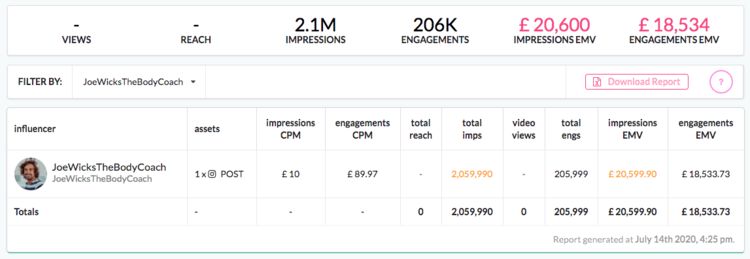So first off, what is Earned Media Value?
The term Earned Media Value (EMV) has long been used in the PR world, to help track and analyze the value of a branded story that has been featured in a newspaper, website, magazine or on TV – for free. So it’s the estimated VALUE of the exposure and recognition, that was EARNED without having to spend any MEDIA dollars to secure it.
In the digital marketing space, EMV is mainly used when talking about social content, so how many impressions or engagements (likes + comments) does organic social content deliver to your business – either from your own or 3rd party social channels (e.g. influencers) and what’s the estimated value of this to your business.
EMV can also help brands set benchmarks for different types of social content and channels, so they can make informed decisions on where to spend their marketing and PR budgets, based on EMV metrics.
How can EMV be used to analyze your influencer activities?
Some brands like to send free products or gifts to influencers, or invite them to special launch events. The hope is that the influencers will test the product or attend the event, and then create some amazing content and share it across all their channels – at no charge, other than the cost of the product provided.
Also, influencers like to create their own product reviews or hauls, to provide their audience with their unbiased opinions on new products – especially in the fashion and beauty industries.
In both of these scenarios (gifting campaigns or independent influencer product reviews), it’s hard to measure the marketing ROI from this activity, as the brand hasn’t paid for the content directly. This is where EMV can really help brands understand the impact of this free social content – and help guide future strategic marketing decisions e.g. which influencers are worth collaborating with or which social channels and formats deliver the most value to your business.
Different methods for calculating EMV
Calculating EMV can help you understand how effective your influencer activities have been. Outlined below are a couple of different methods for generating the EMV metrics, based on your marketing KPIs:
1. Impressions EMV
If your objective is to drive brand awareness, then tracking and calculating an Impression EMV is a good place to start. First off, you need to set an effective ‘Impression CPM’ (cost per thousand impressions), which can be based on your known digital media rates, or analysing previous paid influencer campaigns. You can then calculate the Impressions EMV by multiplying the Impression CPM by the free impressions delivered / 1,000.
2. Engagements EMV:
If engagement in the content is more important to your marketing strategy, you can also track an Engagement EMV. As before, set an Engagement CPM, based on your prior marketing data – then multiply the Engagement CPM by the free engagements delivered (likes + comments) / 1,000.
Using dyzio to track EMV
Dyzio provides the tools to easily track, calculate and report both the Impression and Engagement EMVs, at the influencer and campaign level. You can set the Impression & Engagement CPM values for each campaign and then view the EMV report from the campaign dashboard – which is easy to share with colleagues or clients.
Dyzio can base the EMV metrics on REAL impression data, via influencer authentication, or estimate the impressions for you, based on ratios.

If you’d like to see how easy it is to create and automatically track the Earned Media Value from your influencer activities, please click below to book a demo.
Photo by Daria Nepriakhina

